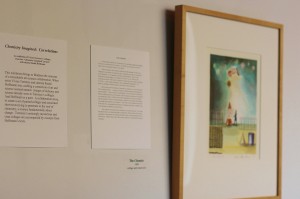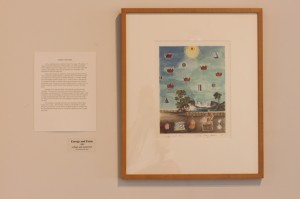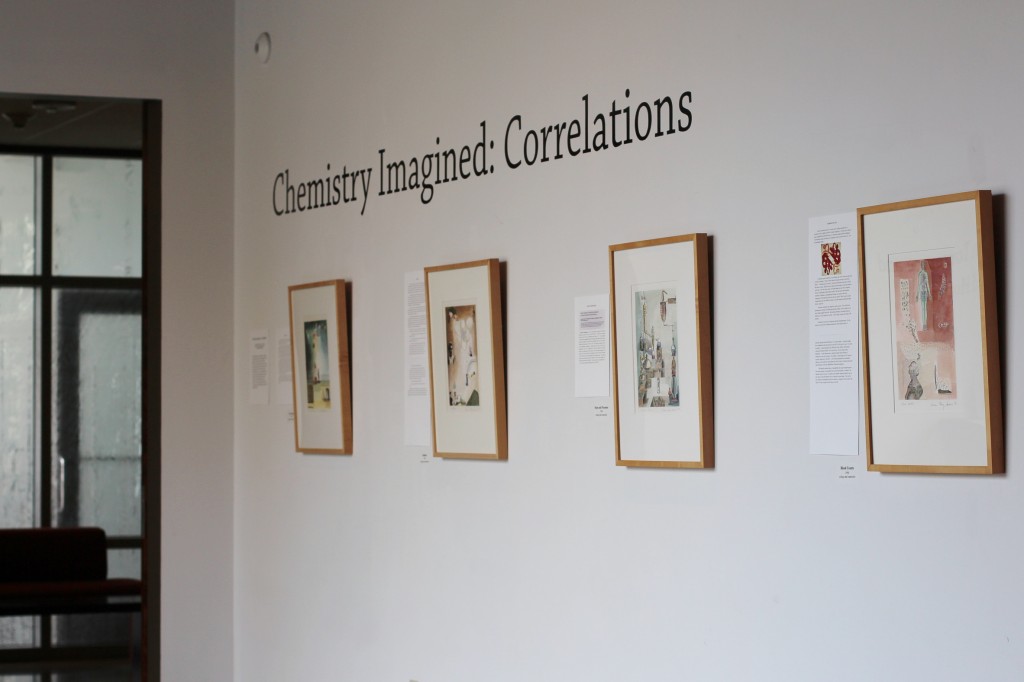Chemistry Imagined: When science and art collide
By Shannon Okas ’14
Science and art seem to be topics that most people instinctively categorize as polar opposites: left brain versus right brain, logic versus creativity. This is exactly why Vivian Torrence’s latest artistic endeavor is both bold and intriguing. Her exhibition, Chemistry Imagined: Correlations, sponsored by the Wisconsin Science Festival and displayed in Union South’s Gallery 1308, has accomplished the difficult task of linking science and art by bringing together diverse elements to form a thought-provoking collage. We got an inside look into the background, goals and interpretations of this exhibition in an interview with the artist herself.
A lot of people seem to think that science and art don’t mesh, how do you respond to that view?
That is precisely the reason to do such collaboration. Science is science and art is art, but we—the mind and spirit—are the connection. My art is in the collage medium, which has within it a synthesis of idea and method. By bringing diverse elements together, I am inventing a story and making something believable out of them. I especially like book engravings from 19th century science—natural philosophy. They provide a wide range of subject images, and I find a certain magic in them. The collage construction is puzzle-like which underscores the ambiguities with which you are confronted. I paint them with watercolor giving them mood and atmosphere less real than expected sometimes. The works hold associations that can create connections between artist and viewer.
 What inspired you to create cohesive works of science and art?
What inspired you to create cohesive works of science and art?
I met Professor Roald Hoffmann at the Djerassi Artist Residency program where we each had fellowships to spend uninterrupted time on. For me, this time was spent on creative work—painting and drawing, for him—writing poetry. He noted from a catalog of my work there was a thread of science running through my collages. We decided to find a way to bring art and science together, using chemistry as a core theme in a series of collages. A variety of writing possibilities opened for Roald to explore.
Describe your experience working with scientist Roald Hoffman. Did you face any challenges with the collaboration, and what was most exciting about it?

Professor Hoffmann’s science is renowned, of course. Working with him on Chemistry Imagined was a great experience. By nature, Roald is a patient and generous spirit and is dedicated to education. He likes the challenge of explaining complicated concepts in simpler forms, which was essential to my understanding of the science. My challenge was trying to face a modern science which had moved forward into new areas with math abstractions beyond my scope. Our time has its challenges that way – another reason we search for connection. I did have to work hard at understanding a broad range of chemistry concepts.
How was your experience with the Wisconsin Science Festival and the Wisconsin Union for this exhibit? How have these collaborations benefited you and your exhibition?
Our collaboration began with finding 30 core themes in chemistry; they would have to have several layers of meaning that I could take into the narrative. In the Union South exhibition, there are 20 collages and 20 of Roald’s written pieces. There are themes that relate to the basic definition of chemistry as a science, historical concepts and applied chemistry; a balance of the theoretical and practical. Models and symbols are rich in the history of this science. The search is for understanding our world in many facets. It was great.
I have enjoyed working with WARF, the Science Festival organizers and the Union Gallery staff very much. Their insights and efficiency are amazing. The Union South Gallery is an intimate sort of space which is perfect for this exhibition. The staff have worked together beautifully to create and install the placards of Roald’s writing, which are paired with the collages as in the original book published by the Smithsonian. I think the exhibition is a fine experience to bring to campus this year. You can see the connections of art, science and life in our collaboration, so viewers should let their associations wander.
Do you have a favorite piece in this collection?
I do have a favorite piece: “Energy and Form.” They all have stories behind them for me—great people I have met in the sciences, things I have learned.
———-
Shannon Okas is a junior majoring in Journalism – Strategic Communication. To Shannon, Memorial Union is a campus gem that affirms she made the right choice in attending UW-Madison. Along with many other fellow Badgers, her favorite place at the Union is the Terrace. There is no feeling equivalent to sitting at a table, soaking in the view, spending time with friends, and knowing that everybody there is making memories that will last a lifetime.


